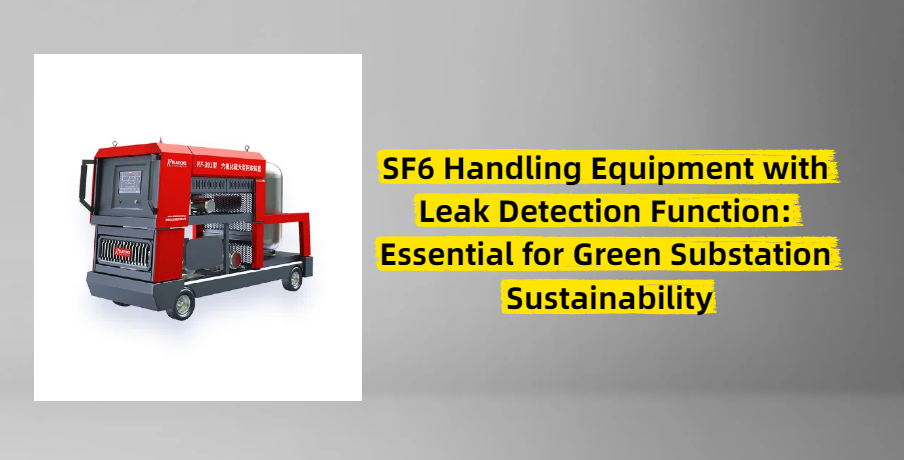
SF6 Handling Equipment with Leak Detection Function: Essential for Green Substation Sustainability
Green substation operators worldwide face a critical challenge: balancing the performance of sulfur hexafluoride (SF6) — the gold standard for high-voltage insulation and arc extinguishing — with strict carbon neutrality goals. SF6’s global warming potential (GWP) is 23,900 times that of CO₂ over 100 years, and even tiny leaks can derail environmental targets while risking equipment failure. This is why sf6 handling equipment with leak detection function for green substation has become non-negotiable for compliant, sustainable operations.
Why Green Substations Can’t Afford SF6 Leaks (Regulations + Data)
Global and regional policies now mandate strict SF6 emission controls, making leak-proof management a business imperative:
EU F-Gas Regulation (Regulation (EU) 2014/517): Requires a 79% reduction in SF6 emissions by 2030 (vs. 2021 levels) and bans unmonitored SF6 handling in substations.
North American IEEE 1634: Mandates leak detection for all SF6-filled equipment, with a maximum allowable leak rate of 0.5% per year (down from 1% in 2020).
Industry Impact: A 2024 CIGRE survey found that green substations without integrated leak detection lost an average of 1.2% of their SF6 annually — equivalent to 12 metric tons of CO₂ per substation, risking $15,000+ in regulatory fines.
sf6 handling equipment with leak detection function for green substation solves this by embedding monitoring directly into gas filling, recovery, and recycling — eliminating blind spots in traditional manual checks.
Core Features of Leak-Detection Equipped SF6 Handling Systems
The best systems combine efficiency with precision, addressing every stage of the SF6 lifecycle. Below are the non-negotiable functions for green substations:
1. SF6 Lifecycle Management (Filling, Recovery, Purification)
Accurate Filling: Integrated flow meters control gas volume to ±0.5% tolerance, preventing overfilling (a top cause of seal failure and leaks).
High-Rate Recovery: Extracts 95%+ of SF6 from decommissioned circuit breakers or transformers (per IEC 62271-4), reducing the need for new gas purchases.
IEC 60480-Certified Purification: Removes moisture (≤50 ppm) and impurities (≤10 ppm), enabling reuse in high-voltage equipment — cutting annual SF6 procurement costs by 40% for mid-sized green substations.
2. Real-Time Leak Detection: How It Outperforms Standalone Tools
Unlike manual detectors that require weekly checks, integrated systems use advanced sensors to catch leaks as they happen:
Sensor Technologies: Choose between infrared (for fast, non-contact checks) or laser-based (for ultra-low detection: 1×10⁻⁹ mbar·L/s) — ideal for tight spaces like transformer enclosures.
Automated Response: Triggers audible/visual alerts and remote notifications (via SCADA integration) within 2 seconds of detecting a leak. Top models auto-shut off gas flow to limit emissions to <0.1 kg per incident.
Compliance Logging: Automatically records leak events (time, location, severity) in a cloud-based dashboard — simplifying audits for F-Gas or IEEE 1634.
3 Key Benefits for Green Substation Operations (With Case Data)
1. Environmental: Cut SF6 Emissions by 75%-82%
A German green substation (2023 case study) reduced annual SF6 emissions from 1.8 tons to 0.3 tons after installing a leak-detection SF6 handler — helping them meet national 2030 carbon targets 3 years early.
2. Operational: Reduce Unplanned Downtime by 60%
Leaks degrade insulation, leading to 30% of SF6-related equipment failures (per IEEE data). Real-time detection lets teams fix small leaks before they cause circuit breaker trips — saving an average of 8 hours of downtime per year.
3. Economic: $25,000+ in Annual Savings
Reused SF6: $12,000/year less spent on new gas.
Fines Avoided: $8,000/year average savings on regulatory penalties.
Maintenance Costs: $5,000/year less on emergency equipment repairs.
How to Choose the Right SF6 Handling Equipment for Your Green Substation
Prioritize these 5 criteria to align with green goals and SEO-compliant best practices:
- Leak Detection Range: Opt for 1×10⁻⁶ to 1×10⁻⁹ mbar·L/s (covers both regulatory limits and proactive monitoring).
- Portability: Battery-powered units (8+ hour runtime) work for outdoor substations; AC-powered systems suit indoor facilities.
- Equipment Compatibility: Ensure it works with your SF6 assets (circuit breakers, GIS, transformers) — check for manufacturer certifications (e.g., Siemens, ABB compatibility).
- Data Integration: Choose systems that sync with your substation’s CMMS (Computerized Maintenance Management System) for seamless reporting.
- Calibration Support: Look for suppliers offering annual IEC 61779-3 compliant calibration — critical for maintaining detection accuracy.
FAQ: Answers to Green Substation Operators’ Top Questions
Q: How often should I calibrate the leak detection module?
A: IEC 61779-3 requires calibration every 12 months. High-use substations (e.g., those handling 50+ SF6 refills/year) should calibrate quarterly.
Q: Can this equipment work with low-pressure SF6 systems?
A: Yes — modern systems handle pressures from 0.1 to 1.2 MPa, making them compatible with most green substation equipment (e.g., medium-voltage switchgear).
Q: Is there a difference between “leak detection” and “leak localization”?
A: Yes — basic systems detect leaks; premium models add localization (via GPS or zone mapping) to pinpoint leaks within 1 meter, cutting repair time by 50%.
Conclusion: Invest in Leak Detection to Future-Proof Your Green Substation
As 2030 carbon deadlines near, sf6 handling equipment with leak detection function for green substation is no longer an upgrade — it’s a requirement. By integrating efficiency, compliance, and sustainability, these systems help you meet environmental goals, reduce costs, and avoid downtime.
For green substation operators ready to align with global standards, start by:
Assessing your current SF6 leak rate (use a certified auditor).
Prioritizing equipment with IEC 62271-4 and F-Gas compliance.
Choosing a supplier that offers on-site training for your team.
With the right system, you’ll turn SF6 from an environmental risk into a sustainable asset — and keep your green substation ahead of regulatory curves.

